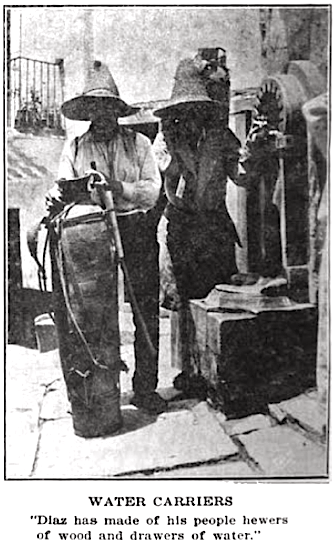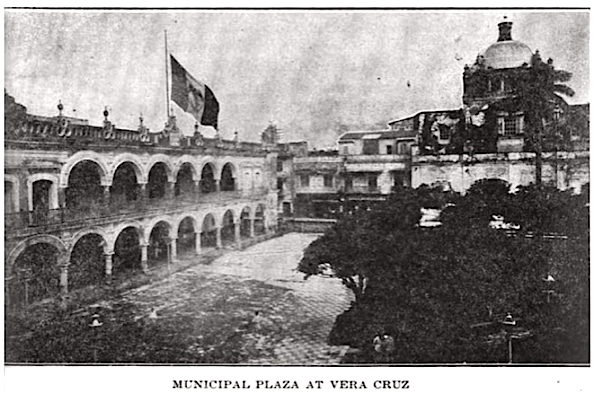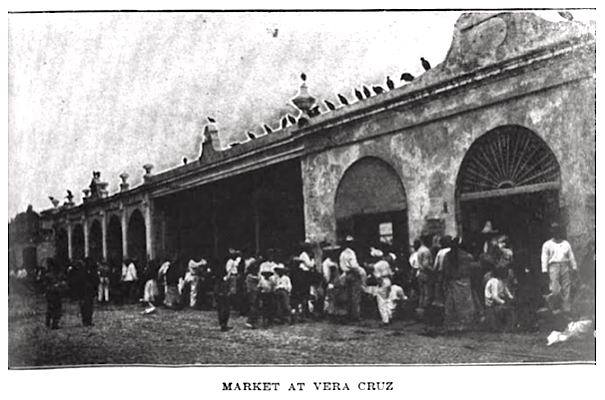 ———-
———-
Hellraisers Journal – Monday April 5, 1909
John Murray on the Horrors of the Private Prisons of Diaz, Part II
From the International Socialist Review of April 1909:
[Part II]
[John Murray at San Juan de Ulua Prison, continues speaking with the sympathetic soldier…]
Without a word the soldier turned and walked towards the archway. I followed at his heels and we made our way around outside the walls, entered the arsenal and climbed an inner staircase to the battlements of the fortress.
Pointing out to sea, my guide showed me a small man-of-war coming into the harbor.
“That’s the ‘General Bravo’—look at it. Keep looking at it, senor, and while we are here alone I will stand behind your back and tell you all I know of the martyrs imprisoned in Ulua.
“The friends of Magon in the army are many. Here, in Ulua, all would be glad to see a way out of this hell—but will it ever come?”
I answered as I believed, in all sincerity, “It will come,” and with a look of encouragement the young soldier went on:
Six months ago I came to Ulua from Sonora, and never once have I seen the political prisoners. But this I saw with my own eyes:
Late on a Sunday afternoon, a boat with two occupants came rowing towards the guardhouse of the west side landing. I saw it before the others, being far-sighted, and this my first day of guard duty on the island. As the boat touched the pier, a white-haired lady wrapped in a black shawl, and trembling with age, was just able to mount from the rocking gunnel to the first stone step, where she sank down, panting and exhausted. The oarsman was a small, black Indian from the mountain tribes near Orizaba. Martin Jose Pico, our hook-nosed, thief-of-a-sergeant—ration-robbing is his trade-roughly demanded her pass, but she had none.
This was such a strange occurrence—a white-haired woman of over eighty years trying to gain entrance to the prison without credentials—that the officer of the day was summoned.
Captain Garcia likes not old women, and to the black figure seated at his feet on the stone step, his words were short and sharp:
“Speak! What do you want?”
“To see a boy who is imprisoned here,” replied the trembling, low-toned voice of the old lady.
“A boy? We have no boys. Who is he?” testily demanded the officer.
“Juan Sarabia,” replied the white-haired woman.
At this name the captain took a sudden step back, for of all the prisoners most strictly kept “incommunicado” is this famous revolutionist, Juan Sarabia. Even to mention his name is forbidden the soldiers of Ulua.
White-faced, the officer gripped the old lady by her arm and stuttered a rasping question:
“Fool! who are you?”
“His mother,” came the answer.
We had crowded round behind the captain, but at this climax, cold chills crept down our backs. The comandante would investigate all this and the least suspicion of sympathy for the politicals, even from the mouth of a mother, would bring quick punishment on all concerned. Through the captain’s mind the same trouble-thoughts were running, and, commanding the sergeant to imprison the old lady in the guard house until he could make a report to the comandante, Captain Garcia hurried to the castle, leaving the order to place a man in the boat with the Indian who brought her over.
A special escort came back with the captain, the castle’s launch was ordered out, and the whole party went over to the mainland, taking the old lady and her Indian with them. The comandante feared the beginning of a plot to rescue the politicals, for well he knew that Vera Cruz swarms with their friends.
The soldier stopped. I was in a fever of curiosity to hear the end. “Go on, man! What happened to Sarabia’s mother?”
Still he was silent and turning to look at him, I saw the cause. Two officers were mounting the steps behind us.
The smaller of the two white-frocked figures approached me. “A beautiful view, senor, but unfortunately, it is an order that no visitor should remain in the fortress after six o’clock—and it is now a few minutes of that time.”
I nodded in acquiescence, presented the officer with a cigar, diplomatically praised the military power of Diaz, and turned sadly from the white walls that held the political prisoners that I could not see. On my return across the bay, Alfredo tried to question me, but I was dumb, and immediately on landing hurried towards the meeting place agreed upon between myself and the secretary.
Crowds surged through the main thoroughfares of Vera Cruz seeking in the cool darkness of the tropical summer night relief from the humid, sticky heat of the day. On the pavements, under the archways, were rows of small tables before which sat the cosmopolitan gatherings of a seaport. Captains and their mates, sailors and stevedores, merchants and hacendados from the henequen and rubber plantations of Yucatan and the cane fields of the Tehuantepec isthmus, all drank, smoked, and gabbled of the state of trade or the lucky number in the municipal lottery.
It was in the back room of a small bar facing the fish market that I met the group of revolutionists that form the nucleus of the Liberal Party in the State of Vera Cruz. The president, a swarthy little man from Merida, gripped me by the hand as the secretary told of my trip to San Juan de Ulua.
[Concluded the secretary:]
That soldier should be of use to us. He must be one of the battalion drafted from among the miners that went on strike at Cananea, where hundreds were shot down by Greene’s cowboys and Kosterlitsky’s rurales.
[And the president bitterly added:]
And where eight leaders of the Mexican miners were hung on trees.
“Aye!” chimed in one from the ring of dark eyes and faces that surrounded us, “but it were better to hang in Sonora than to be buried alive in Ulua. Let the senor talk with Antonio.”
I turned questioningly to the president.
[He declared with fierce bitterness:]
Yes, you shall see him. At least what is left of him-a mere shaking shadow of our brave Antonio. And yet tomorrow he must leave Vera Cruz and begin the journey to the mountains of Oaxaca, lest the police-dogs discover him in his present hiding-place. But you shall see him tonight. Come.
Following the president, I climbed the stairway to the top story of the building, where, in an inner room, guarded by a white-haired old woman, lay a man upon a canvas cot. How any one could imagine that this gasping remnant of manhood would ever gather strength enough to leave his room and travel back to his home in the Oaxacan Mountains was a mystery to me. He was near death—no one could doubt it—death by consumption.
Placing a high-backed chair at the head of his cot, the old lady bolstered him up with pillows, and for a moment his claw-like, nerveless hand lay in mine.
But there was life left in his eyes, and when he was told of my purpose in coming to Vera Cruz he, too, asked me the question that seems to be first on the tongues of all Mexicans, “How is Ricardo?”
While I answered the plaintive query he struggled to suppress a rack ing cough and to gather strength to tell me the latest news from that underground purgatory of which all patriotic Mexico was burning to hear. These are his words:
My escape is proof that the army of Diaz is honey-combed with men ready to revolt. I say this because without the aid of the soldiers, I would still be in San Juan de Ulua.
It was on the day of our great national celebration, “Cinco de Mayo,” that a soldier, strange to all of us, passed, before our cell door. But on his return I felt sure that I knew him, although the light of the lantern that he carried showed me his face but for the space of an instant. I was right—it was my brother.
You may ask how we knew the days of the year, buried as were in darkness, but we did, for Cesar Canales kept a record by marks scratched into the soft stone walls which he could feel with his finger tips and the “Cinco de Mayo” was the four hundred and twenty-second day of our imprisonment.
Day after day, I waited for the return of my brother. It was five days before he came, and then I spoke and he knew me. He, too, had tasted the bitterness of the rule of tyranny. The jefe politico had cast eyes upon my brother’s wife and in consequence he had been drafted into the army. After six months of service his company was transferred to the fortress. He had no idea that the island held another of our unfortunate family.
With the help of two other soldiers my escape was planned and successfully carried out. It was a mere matter of a change of clothes, first to the uniform of a soldier, and then into the blue overalls of a day-worker in the arsenal. You must know that every morning a boat load of men comes from the city to work in the arsenal, returning each night. It was among these people that I escaped to shore and was hidden by friends. Soon I shall go south to the mountains of Oaxaca.
———-
[Emphasis added.]
~~~~~~~~~~~~~~~~~~~~~~
SOURCES & IMAGES
Quote R Magon re John Murray, ISR p643, Mar 1909
https://play.google.com/books/reader?id=Z6o9AAAAYAAJ&hl=en&pg=GBS.PA643
The International Socialist Review, Volume 9
(Chicago, Illinois)
-July 1908-June 1909
Charles H. Kerr & Company, 1909
https://books.google.com/books?id=Z6o9AAAAYAAJ
ISR – Apr 1909
https://play.google.com/books/reader?id=Z6o9AAAAYAAJ&hl=en&pg=GBS.PA736
“The Prisons of Diaz” by John Murray
https://play.google.com/books/reader?id=Z6o9AAAAYAAJ&hl=en&pg=GBS.PA737
“Without a word the soldier turned…”
https://play.google.com/books/reader?id=Z6o9AAAAYAAJ&hl=en&pg=GBS.PA743
See also:
Hellraisers Journal: From the International Socialist Review:
John Murray on the Horrors of the Private Prisons of Diaz, Part I
Tag: San Juan de Ulua Prison Mexico
https://weneverforget.org/tag/san-juan-de-ulua-prison-mexico/
Tag: Ricardo Flores Magón
https://weneverforget.org/tag/ricardo-flores-magon/
Tag: Cananea Copper Strike of 1906
https://weneverforget.org/tag/cananea-copper-strike-of-1906/
For more on “Greene’s cowboys and Kosterlitsky’s rurales”
[also Kosterlitzky], see:
Continental Crossroads
Remapping U.S.-Mexico Borderlands History
-ed by Samuel Truett and Elliott Young
Duke University Press, 2004
(search separately: cananea; greene; ksoterlitzky)
https://books.google.com/books?id=XutSuKkNTcgC
For a bit more on César Canales, see:
The Return of Comrade Ricardo Flores Magón
-by Claudio Lomnitz
Zone Books, 2014
(search: canales)
https://books.google.com/books?id=DqIEAwAAQBAJ
~~~~~~~~~~~~~~~~~~~~~~~~~~~~~~~~~~~~~~~~~~~~~
In honor of the Cananea Martyrs of June 1906
WE NEVER FORGET



